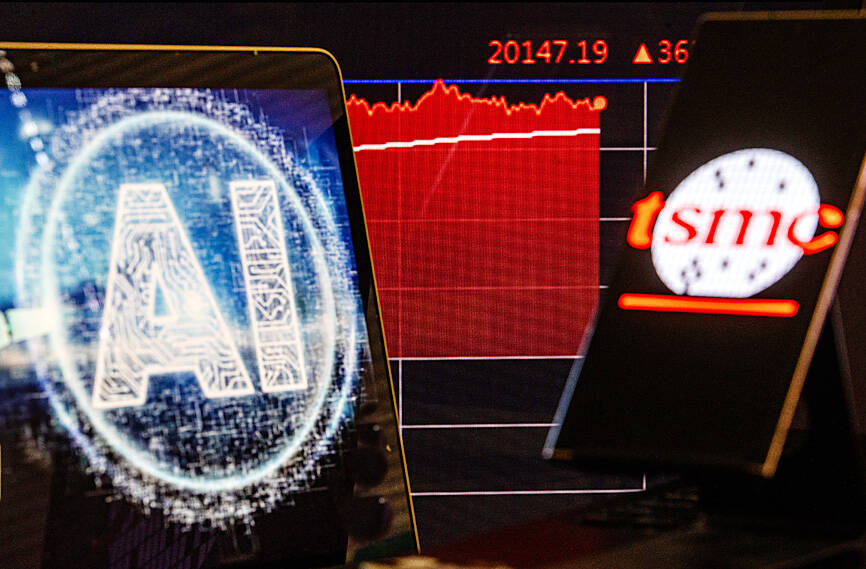The TAIEX yesterday soared more than 400 points to close above 20,000, hitting a fresh closing high as buying was sparked by rallying US markets overnight.
Gains were seen across the board with investor sentiment boosted by a dovish US Federal Reserve, which on Wednesday left its key interest rates unchanged, but hinted at three rate cuts this year.
The TAIEX closeed up 414.64 points, or 2.10 percent, at 20,199.09, with turnover totaling NT$486.001 billion (US$15.27 billion) on the main board, Taiwan Stock Exchange data showed.

Photo: CNA
The market opened flat, but momentum soon picked up as investors were motivated by the strong gains posted by the Dow Jones Industrial Average and the tech-heavy NASDAQ, both of which hit new highs overnight, dealers said.
The strength of the TAIEX continued into the end of the session on the back of a strong performance by large-cap stocks in the bellwether electronics sector and the non-technology sector, dealers added.
“The Fed implied it will lower interest rates three times this year in its updated ‘dot plot,’ which eased market concerns that the US central bank would only implement two rate cuts,” Moore Securities Investment Consulting Co (摩爾投顧) analyst Adam Lin (林漢偉) said.
A dot plot is a chart updated quarterly that records each Fed official’s projection of interest rate movements and indicates what the central bank might do next regarding monetary policy.
“It’s not just the Taipei market, other regional markets such as Tokyo and Seoul also moved sharply higher,” Lin said. “Judging from the movement in the TAIEX today, I think both foreign and local institutional investors were on the buy side. These institutional investors were more willing to take risks and take advantage of the Fed’s stance. This led to them rebuilding their positions and picking up large-cap stocks across the board, which made buying appear strong.”
Foreign institutional investors bought a net NT$18.36 billion of shares on the main board yesterday, with local investment trust firms registering a net buy of NT$11.17 billion.
The electronics index and semiconductor subindex rose 2.47 percent and 2.85 percent respectively, led by contract chipmaker Taiwan Semiconductor Manufacturing Co (TSMC, 台積電), the most heavily weighted stock on the local market.
TSMC rose 3.43 percent to close at NT$784 and the stock’s gains contributed about 210 points to the TAIEX’s rise yesterday.
Among other semiconductor stocks, DRAM chip supplier Nanya Technology Corp (南亞科技) soared 10 percent and rival Winbond Electronics Corp (華邦電子) also surged 6.33 percent after US-based Micron Technology Inc reported better-than-expected results for its fiscal second quarter.
Lin said buying spread to other technology heavyweights outside the semiconductor industry, including iPhone assembler Hon Hai Precision Industry Co (鴻海精密), second to TSMC in terms of market value, which rose 3.26 percent to close at NT$142.5 on the back of high hopes about its artificial intelligence development.
“Large-cap old economy and financial stocks also trended much higher today. These non-tech stocks had lagged behind their electronics counterparts for some time and such gains suggest a technically healthy TAIEX, but investors should keep alert over the March inflation data in the US as raw material prices have moved higher, which could affect the US markets and in turn impact shares in other markets, including in Taiwan,” Lin said.

Intel Corp chief executive officer Lip-Bu Tan (陳立武) is expected to meet with Taiwanese suppliers next month in conjunction with the opening of the Computex Taipei trade show, supply chain sources said on Monday. The visit, the first for Tan to Taiwan since assuming his new post last month, would be aimed at enhancing Intel’s ties with suppliers in Taiwan as he attempts to help turn around the struggling US chipmaker, the sources said. Tan is to hold a banquet to celebrate Intel’s 40-year presence in Taiwan before Computex opens on May 20 and invite dozens of Taiwanese suppliers to exchange views

Application-specific integrated circuit designer Faraday Technology Corp (智原) yesterday said that although revenue this quarter would decline 30 percent from last quarter, it retained its full-year forecast of revenue growth of 100 percent. The company attributed the quarterly drop to a slowdown in customers’ production of chips using Faraday’s advanced packaging technology. The company is still confident about its revenue growth this year, given its strong “design-win” — or the projects it won to help customers design their chips, Faraday president Steve Wang (王國雍) told an online earnings conference. “The design-win this year is better than we expected. We believe we will win

Chizuko Kimura has become the first female sushi chef in the world to win a Michelin star, fulfilling a promise she made to her dying husband to continue his legacy. The 54-year-old Japanese chef regained the Michelin star her late husband, Shunei Kimura, won three years ago for their Sushi Shunei restaurant in Paris. For Shunei Kimura, the star was a dream come true. However, the joy was short-lived. He died from cancer just three months later in June 2022. He was 65. The following year, the restaurant in the heart of Montmartre lost its star rating. Chizuko Kimura insisted that the new star is still down

While China’s leaders use their economic and political might to fight US President Donald Trump’s trade war “to the end,” its army of social media soldiers are embarking on a more humorous campaign online. Trump’s tariff blitz has seen Washington and Beijing impose eye-watering duties on imports from the other, fanning a standoff between the economic superpowers that has sparked global recession fears and sent markets into a tailspin. Trump says his policy is a response to years of being “ripped off” by other countries and aims to bring manufacturing to the US, forcing companies to employ US workers. However, China’s online warriors